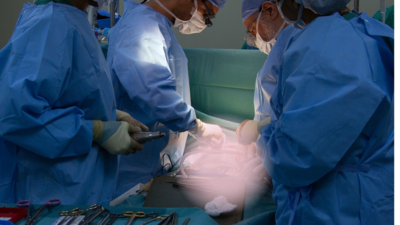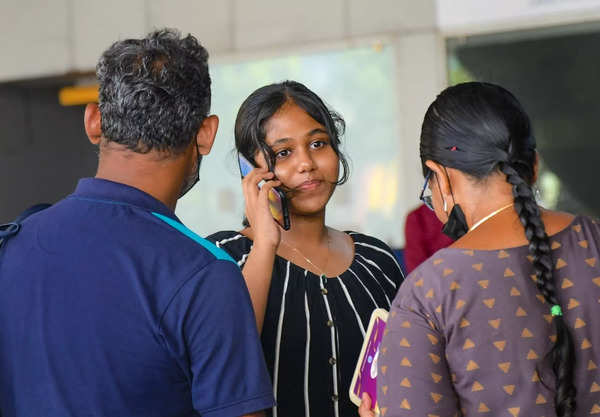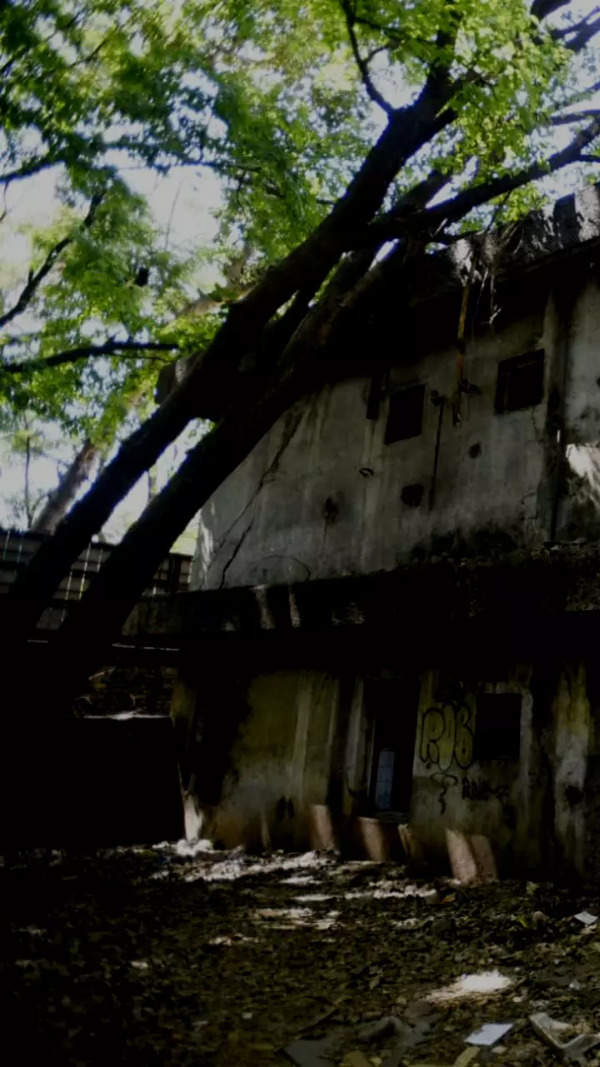- News
- City News
- delhi News
- 2-month-old child diagnosed with rare yeast infection gets new lease of life at Noida hospital
Trending Topics
2-month-old child diagnosed with rare yeast infection gets new lease of life at Noida hospital

A two-month-old baby boy from Uttar Pradesh, who was diagnosed with a rare yeast infection coupled with cytomegalovirus meningitis (CMV), has received a new lease of life after undergoing treatment at a Noida hospital, doctors said on Tuesday.
NEW DELHI: A two-month-old baby boy from Uttar Pradesh, who was suffering from a rare yeast infection and cytomegalovirus meningitis (CMV), successfully treated at a hospital in Noida.
Fortis Hospital in a statement claimed that this was the first reported case in the world of a Rhodotorula infection (a genus of pigmented yeasts) combined with CMV.
The infant, who hailed from Mathura, was admitted to the hospital recently.
The infant was admitted to the hospital with "fever, increased irritability and two episodes of abnormal movements, including up-rolling of eyes, bulging in the top of head and irritable cry", the statement said.
According to doctors, a number of medical examinations, including an MRI and CSF test, were performed to detect any potential infection. These tests ultimately confirmed that the infant was suffering from meningitis.
"Owing to the uncontrolled seizures, the baby was intubated and administered antibiotics. Clinically, the baby showed improvement with satisfactory feeding and activity, but his high-grade fever was not getting better. He was having 3-4 episodes of fever everyday, thus a CSF examination was repeated and sent for a Biofire test which was CMV positive," the statement said.
"Injection Ganciclovir was administered for six weeks. However, fever didn't subside even after 10 days of IV Ganciclovir being administered. The CSF fungal culture revealed the presence of Rhodotorula infection, reported for the first time across the globe," the hospital claimed.
It also claimed that this is the "second reported case of CMV meningitis diagnosed via Biofire" (an infection and inflammation of the lining of the brain, caused by a virus named CMV (cytomegalovirus) in the world as per the available medical records.
Elaborating on the case, Dr Ashutosh Sinha, director and head of paediatrics department, Fortis Noida, said, "The baby was initially treated with IV antibiotics and IV antiepileptics. However, he had multiple episodes of seizure, for which he was electively intubated and put on mechanical ventilation and IV midazolam infusion".
The baby was extubated after 48 hours of being seizure-free. Clinically, the baby showed improvement but high-grade fever was not getting better. Subsequently, cytomegalovirus meningitis (CMV) was detected, Sinha said.
"The infant was then injected with Ganciclovir which continued for six weeks. However, the fever continued for 10 days. A repeat CSF fungal culture revealed the presence of a rare yeast -- Rhodotorula species, which has not been identified or observed in CMV anywhere in the world," the hospital claimed.
Then Amphotericin B was started and continued for four weeks, which helped the baby recover and his fever also subsided. Without immediate and correct treatment, the "chances of survival were meagre", the doctors said.
"Initial MRI had shown changes in the brain, but subsequent MRI showed improvement and we discharged the baby in normal condition without any complications. The condition has risk factors - high mortality, neurodisability and other related complications if left undiagnosed and untreated," Sinha said.
Cytomegalovirus is a common virus and once infected, the body retains the virus for life. Most people don't know they have CMV because it rarely causes problems in healthy people. This infection generally happens in immunocompromised and HIV patients or those undergoing chemotheraphy, the head of paediatric department said said.
"There have been cases of CMV infection in babies acquired before birth from mother or after birth through breast milk but infection of the brain is very rare. Some babies can acquire it after birth via breast milk. However, in this case, it was not possible to ascertain if breast milk was the carrier, although we stopped breast milk to limit the exposure," he said.
Dr Shubham Garg, senior consultant, surgical oncology, at the hospital, who evaluated and advised for a chemoport in this case, said, "Finding a vein to administer IV medications is always a challenge in infants. This was a 2-month-old child and we needed immediate administration of intravenous medications for more than a month."
"Chemoport is usually used in patients who require multiple cycles of chemotherapy. It is placed in the skin below the clavicle and is connected to a large vein using a catheter. In this case, this was a challenge as the diameter of the catheter might not fit the small vessels or veins. Thus, we ordered a special small-sized port (6F) and were able to place it successfully with the help of anaesthesia," he said.
(With inputs from PTI)
Fortis Hospital in a statement claimed that this was the first reported case in the world of a Rhodotorula infection (a genus of pigmented yeasts) combined with CMV.
The infant, who hailed from Mathura, was admitted to the hospital recently.
The infant was admitted to the hospital with "fever, increased irritability and two episodes of abnormal movements, including up-rolling of eyes, bulging in the top of head and irritable cry", the statement said.
According to doctors, a number of medical examinations, including an MRI and CSF test, were performed to detect any potential infection. These tests ultimately confirmed that the infant was suffering from meningitis.
"Owing to the uncontrolled seizures, the baby was intubated and administered antibiotics. Clinically, the baby showed improvement with satisfactory feeding and activity, but his high-grade fever was not getting better. He was having 3-4 episodes of fever everyday, thus a CSF examination was repeated and sent for a Biofire test which was CMV positive," the statement said.
"Injection Ganciclovir was administered for six weeks. However, fever didn't subside even after 10 days of IV Ganciclovir being administered. The CSF fungal culture revealed the presence of Rhodotorula infection, reported for the first time across the globe," the hospital claimed.
It also claimed that this is the "second reported case of CMV meningitis diagnosed via Biofire" (an infection and inflammation of the lining of the brain, caused by a virus named CMV (cytomegalovirus) in the world as per the available medical records.
Elaborating on the case, Dr Ashutosh Sinha, director and head of paediatrics department, Fortis Noida, said, "The baby was initially treated with IV antibiotics and IV antiepileptics. However, he had multiple episodes of seizure, for which he was electively intubated and put on mechanical ventilation and IV midazolam infusion".
The baby was extubated after 48 hours of being seizure-free. Clinically, the baby showed improvement but high-grade fever was not getting better. Subsequently, cytomegalovirus meningitis (CMV) was detected, Sinha said.
"The infant was then injected with Ganciclovir which continued for six weeks. However, the fever continued for 10 days. A repeat CSF fungal culture revealed the presence of a rare yeast -- Rhodotorula species, which has not been identified or observed in CMV anywhere in the world," the hospital claimed.
Then Amphotericin B was started and continued for four weeks, which helped the baby recover and his fever also subsided. Without immediate and correct treatment, the "chances of survival were meagre", the doctors said.
"Initial MRI had shown changes in the brain, but subsequent MRI showed improvement and we discharged the baby in normal condition without any complications. The condition has risk factors - high mortality, neurodisability and other related complications if left undiagnosed and untreated," Sinha said.
Cytomegalovirus is a common virus and once infected, the body retains the virus for life. Most people don't know they have CMV because it rarely causes problems in healthy people. This infection generally happens in immunocompromised and HIV patients or those undergoing chemotheraphy, the head of paediatric department said said.
"There have been cases of CMV infection in babies acquired before birth from mother or after birth through breast milk but infection of the brain is very rare. Some babies can acquire it after birth via breast milk. However, in this case, it was not possible to ascertain if breast milk was the carrier, although we stopped breast milk to limit the exposure," he said.
Dr Shubham Garg, senior consultant, surgical oncology, at the hospital, who evaluated and advised for a chemoport in this case, said, "Finding a vein to administer IV medications is always a challenge in infants. This was a 2-month-old child and we needed immediate administration of intravenous medications for more than a month."
"Chemoport is usually used in patients who require multiple cycles of chemotherapy. It is placed in the skin below the clavicle and is connected to a large vein using a catheter. In this case, this was a challenge as the diameter of the catheter might not fit the small vessels or veins. Thus, we ordered a special small-sized port (6F) and were able to place it successfully with the help of anaesthesia," he said.
(With inputs from PTI)
Start a Conversation
FOLLOW US ON SOCIAL MEDIA
FacebookTwitterInstagramKOO APPYOUTUBE










